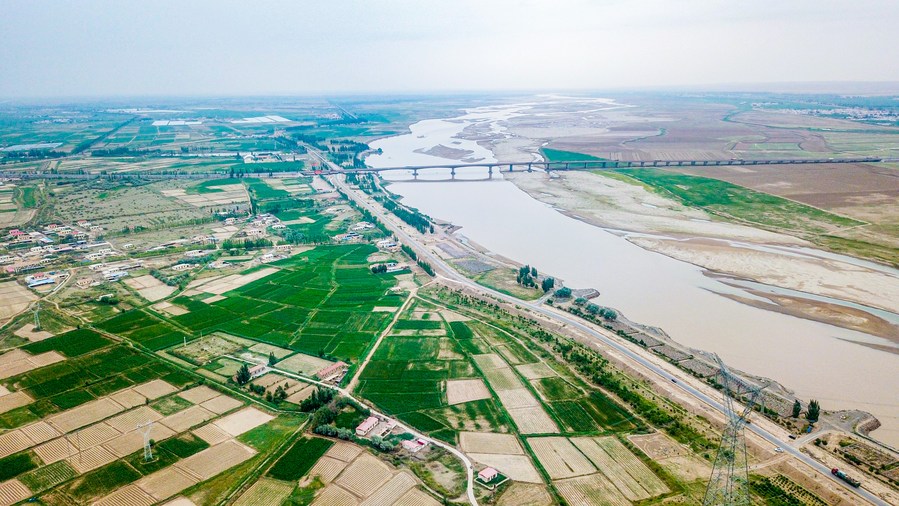
Clouds linger over Dujiangyan Irrigation System after an autumn rain in Chengdu, southwest China's Chengdu Province, October 6, 2023. /CFP
Clouds linger over Dujiangyan Irrigation System after an autumn rain in Chengdu, southwest China's Chengdu Province, October 6, 2023. /CFP
These days, rice produced in the village of Yongfeng is on the market, after being dried and processed for nearly a month.
"We have a bumper harvest of rice this year. The quality of the new rice is very good and tourists who come here during this period usually buy some to take home," said Deng Kai, head of a collectively-owned company in Yongfeng Village, Meishan City in southwest China's Sichuan Province.
It is estimated that the rice yield per hectare this year could reach over 12.9 tonnes, a new high for the village. After harvesting rice, villagers nowadays plant rhizoma alismatis, a traditional Chinese herbal medicine, in the field to improve income. But planting this kind of medicinal herb consumes large amount of water.
Thanks to the Dujiangyan irrigation system located on the Chengdu Plain of the Minjiang River, the village has enough supply of water to include Chinese medicinal herbs in its agricultural production.
With an irrigation area of 755,000 hectares, the Dujiangyan Irrigation System provides irrigation and drainage services for seven cities in Sichuan Province.
In recent years, the 2,000-year-old irrigation system has adopted smart technologies to monitor nearly 1,000 points across its spreading irrigation area, so that it could coordinate services within one system.
Irrigation systems have been playing a key role in boosting agricultural production across China. The total area of irrigation in the country stands at over 70 million hectares, accounting for 55 percent of the country's arable land, producing 77 percent of the country's grain and more than 90 percent of cash crops, according to latest statistics of the Ministry of Water Resources.

This aerial photo shows the Hetao Irrigation Area in Dengkou County in Bayannur, north China's Inner Mongolia Autonomous Region, June 18, 2023 . /Xinhua
This aerial photo shows the Hetao Irrigation Area in Dengkou County in Bayannur, north China's Inner Mongolia Autonomous Region, June 18, 2023 . /Xinhua
An irrigation area can be regarded as a complete engineering system of water transport, distribution, irrigation and drainage. Data show there are 7,326 large and medium-sized irrigation areas in China. According to the Ministry of Water Resources, a large irrigation area can supply water to over 20,000 hectares, and a medium-sized one can serve 667 to 20,000 hectares of land.
With little rainfall and a dry climate, the Hetao Irrigation Area has been diverting water from the Yellow River for agricultural irrigation for over 2,200 years. The irrigation area collects about 4.6 billion cubic meters of water from the Yellow River every year, accounting for one-eighth of the total water diversion in the entire Yellow River basin.
Located in Bayannur, north China's Inner Mongolia Autonomous Region, crops such as wheat, corn as well as sunflower seeds and melons stand on the cusp of its harvest. Serving an area of 730,000 hectares, the annual grain output in the Hetao Irrigation Area is at about three million tonnes.
In recent years, drip irrigation has been promoted in the irrigation area, which has greatly saved agricultural irrigation water. Xinjian Village is one of the villages in Bayannur that introduced this system this year.
"It is very convenient. Just by turning on the drip irrigation system, we can start to irrigate the surrounding 53 hectares of land," said the village's Party secretary Wang Lianzhu.
Bayannur has also set up irrigation water cooperatives to improve the efficient utilization of water resources, incorporating every dike and irrigation channel across the region.
Moreover, data in each water gate and truck channel is collected and updated in real time to monitor the water situation in the whole irrigation area.
"The Hetao Irrigation Area has modernized its information collecting technologies. With one app on a smart phone, we can observe the changes of water level and flow," said Huang Yinqiang, director of a branch water supply station in the irrigation area.